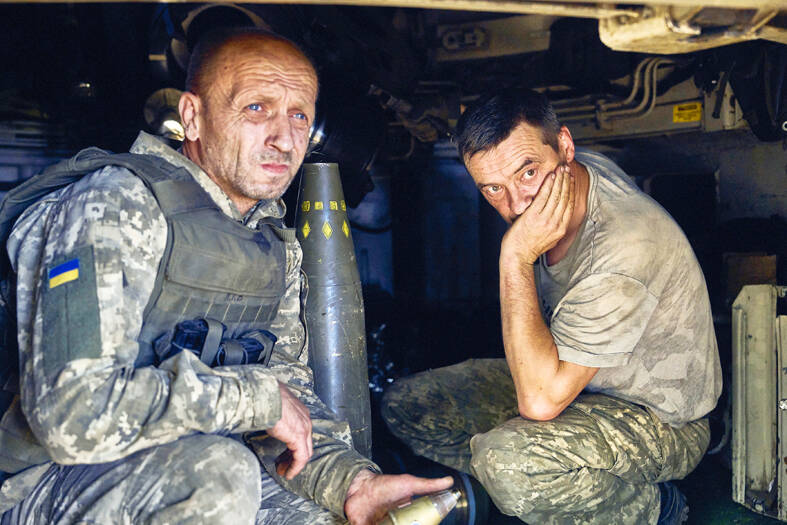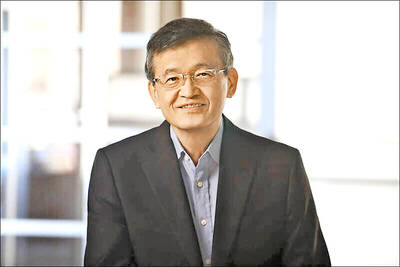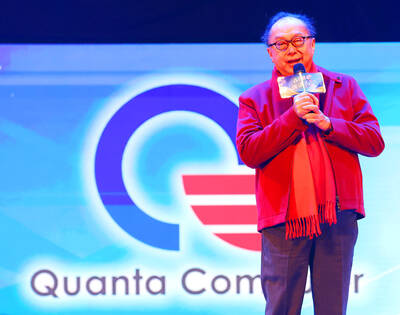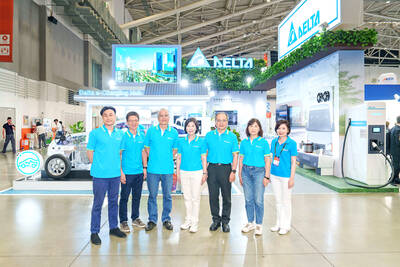The science conference had all the hot topics you would expect, from artificial intelligence (AI) to gene therapy, but this year’s annual gathering of brains in Kyiv had a decidedly Ukrainian twist — the innovations on exhibit were for war.
A maker of attack drones was diversifying to uncrewed ground combat vehicles. From the National Academy of Sciences of Ukraine came a prototype underwater robot for finding and collecting submerged land mines. One start-up was developing low-cost combat communications; another, a Web-based test to find warning signs of post-traumatic stress disorder (PTSD).
In the 18 months since Russia’s invasion, Ukraine’s resilience with the help of weaponry from mainly NATO-member states has come to define the war. Less noticed is a cottage industry of battlefield gadgetry that is starting to bear fruit.

Photo: AP
Ukraine, like Russia, has a robust science base, a legacy of the Soviet-era focus on math and engineering. While no single device is likely to change the course of the conflict, the government is trying to consolidate the nation’s sometimes chaotic entrepreneurial output in the belief that — taken together — it can make a difference.
One such innovation, explosive sea drones, has been under intense development in Ukraine since last year. Last weekend, the newest iterations were able to strike and cripple a Russian warship and oil tanker in the Black Sea. That followed the success of a year-old project that helped accelerate the development and production of aerial drones.
To package everything in one place, the Ukrainian government in April started an incubator for all forms of military innovation, called Brave 1.
Organizers say they have registered about 400 projects in four months, and Ukraine’s armed forces have so far vetted 186 as potentially useful. Sixty are in robotics, more than 25 in AI and 70 are for uncrewed aerial vehicles (UAVs).
“Our task is to develop military technologies in Ukraine,” said Ukrainian Minister for Digital Transformation Mykhailo Fedorov, who described Brave 1 as the institutionalization of his Army of Drones program.
Success would ultimately be judged on how many projects get state contracts, he said.
There are plenty of contenders. Some are adapting existing kit, others are making cheaper versions of Western equipment that Ukraine cannot afford, and others again just respond to feedback from friends on the battlefield.
Take Himera Tech: It set out to build affordable, jam-resistant radio handsets shortly after Russian President Vladimir Putin’s forces attacked in on Feb. 24 last year.
It took until April this year for the first units to roll off their production line and about 600 are in use at the front, Himera Tech cofounder Misha Rudominski said.
The company registered with Brave 1 in May.
The trick to building cheaper is the software the company developed to maximize performance in commercially available chips, Rudominski said.
Radio sets made with military grade chips are more secure, but also cost thousands of US dollars apiece. With as many as 250,000 combat soldiers to equip, that is a bill Ukraine cannot foot.
“We wanted to build a solution that is just good enough,” Rudominski said at his stall at June’s Inscience conference in Kyiv. “This wouldn’t defeat US or Chinese electronic warfare systems, but it doesn’t need to. We’re fighting the Russians.”
Himera Tech expects to produce 2,000 to 3,000 units per month by the end of the year. It is not yet selling to the Ukrainian Ministry of Defense, but that is the aim, and the company reckons it could then scale to 10,000 units per month.
A model that can compete with military grade kit is in development, Rudominski said.
Another Kyiv-based outfit, Power Kit, uses discarded electronic cigarettes to make power banks.
Ivan Volynets, who founded the nonprofit together with five other IT specialists, described how in the first days of the Russian invasion they asked friends on the front line what they needed. The answers boiled down to night vision, power banks and weapons.
They made a night vision device paired with its own power bank and took it to the defense ministry. To their surprise, it was the power banks the army wanted, because they charge all the electronics frontline soldiers rely on, including night-vision gear, drones and communications.
The first Power Kit emerged in May last year, built in the kitchen of the hotel the team were staying at in Lviv, western Ukraine, Volynets said.
They have since made more than 2,100 at a cost of about US$15 each and distribute them free of charge to soldiers.
Yevhenii Rvachov was an IT specialist working with civilian drones in the northern city of Kharkiv before the invasion. He, too, consulted with soldiers after cofounding a company, Skylab UA, to make a bomb-dropping quadrocopter — a drone with four rotors — in April last year.
They told him they needed ground robots to make supplying forward positions less dangerous. So Skylab built the Sirko-S, a remote-controlled go-cart-like carrier with thermal cameras that can be used to bring up supplies or evacuate wounded. They cost US$8,000 to US$10,000 each.
The company’s US$5,000 “Johnny” is a shoe-box-size version, with a view to forward surveillance, kamikaze bombing runs or to help emergency services find survivors in collapsed buildings, Rvachov said.
All three products are registered with Brave 1, with grants approved, according to the organizers, and 10 quadrocopters are in action at the front.
Close to the Polish border, a company called Citius-S is converting six-wheel drive cargo trucks into armored vehicles for clearing land mines and unexploded ordnance.
The State Emergency Service of Ukraine saw the prototype in action last month and ordered 33 units, Citius-S said.
For underwater mines, the Institute for Problems of Artificial Intelligence at the National Academy of Sciences of Ukraine is developing a submersible device to find and retrieve ordnance left behind by the Russians.
A prototype of the cuboid robot just began tests of its electronic systems, said Sergii Simchenko, a doctoral candidate in physics and math at the institute, who is working on the project.
Not every innovation or adaptation is about weapons, though.
The Bohun amphibious all-terrain vehicle has huge tires with fin-like tread to climb over fallen trees or cross lakes and rivers. It was designed for Ukraine’s hunters and fishers, and since the Russian invasion a number were adapted for military use and sent to the front.
However, six of the newer Bohun-2 model were in June converted to help evacuate victims of the flooding around the city of Kherson that followed destruction of a dam on Ukraine’s massive Dnipro River. Lights and loudhailers were added outside the cabins, as well as extra batteries, removable seats and helicopter-ready metal stretchers inside.
Back at the Inscience conference, Anima cofounder Sergiy Danylov was showing off the software his team have created. It uses an image-based test to measure levels of depression and anxiety with a Web cam that follows eye movement to add objectivity.
The test involves looking at a series of trigger images, such as snakes, spiders and mutilated corpses, in each case on a split screen with more emotionally neutral options opposite. The key lies in how subjects respond, with some looking away to avoid the danger signals and others unable to take their eyes off them.
That helps with diagnosis of battle stress, which if caught early can be prevented from developing into PTSD, said Danylov, who has a doctorate in neurobiology.
The Anima program is for now aimed at soldiers and refugees, but the Ukrainian Ministry of Health said last year that PTSD could end up affecting 57 percent of the population.
Anima has given the software to combat psychologists, who are using it unofficially to measure stress levels among troops and rest those at risk. The program has not yet been approved and licensed by the regulator, a years-long process.
Tyet it is already on the radar of the Brave 1 program.
“Know this team,” Iryna Supruniuk, communications lead at Brave 1, said in an e-mailed response to questions.
Anima was not yet on her platform, she said, but it seems only a question of time.
“Really nice solution,” she added.

Intel Corp chief executive officer Lip-Bu Tan (陳立武) is expected to meet with Taiwanese suppliers next month in conjunction with the opening of the Computex Taipei trade show, supply chain sources said on Monday. The visit, the first for Tan to Taiwan since assuming his new post last month, would be aimed at enhancing Intel’s ties with suppliers in Taiwan as he attempts to help turn around the struggling US chipmaker, the sources said. Tan is to hold a banquet to celebrate Intel’s 40-year presence in Taiwan before Computex opens on May 20 and invite dozens of Taiwanese suppliers to exchange views

Application-specific integrated circuit designer Faraday Technology Corp (智原) yesterday said that although revenue this quarter would decline 30 percent from last quarter, it retained its full-year forecast of revenue growth of 100 percent. The company attributed the quarterly drop to a slowdown in customers’ production of chips using Faraday’s advanced packaging technology. The company is still confident about its revenue growth this year, given its strong “design-win” — or the projects it won to help customers design their chips, Faraday president Steve Wang (王國雍) told an online earnings conference. “The design-win this year is better than we expected. We believe we will win

Quanta Computer Inc (廣達) chairman Barry Lam (林百里) is expected to share his views about the artificial intelligence (AI) industry’s prospects during his speech at the company’s 37th anniversary ceremony, as AI servers have become a new growth engine for the equipment manufacturing service provider. Lam’s speech is much anticipated, as Quanta has risen as one of the world’s major AI server suppliers. The company reported a 30 percent year-on-year growth in consolidated revenue to NT$1.41 trillion (US$43.35 billion) last year, thanks to fast-growing demand for servers, especially those with AI capabilities. The company told investors in November last year that

Power supply and electronic components maker Delta Electronics Inc (台達電) yesterday said it plans to ship its new 1 megawatt charging systems for electric trucks and buses in the first half of next year at the earliest. The new charging piles, which deliver up to 1 megawatt of charging power, are designed for heavy-duty electric vehicles, and support a maximum current of 1,500 amperes and output of 1,250 volts, Delta said in a news release. “If everything goes smoothly, we could begin shipping those new charging systems as early as in the first half of next year,” a company official said. The new